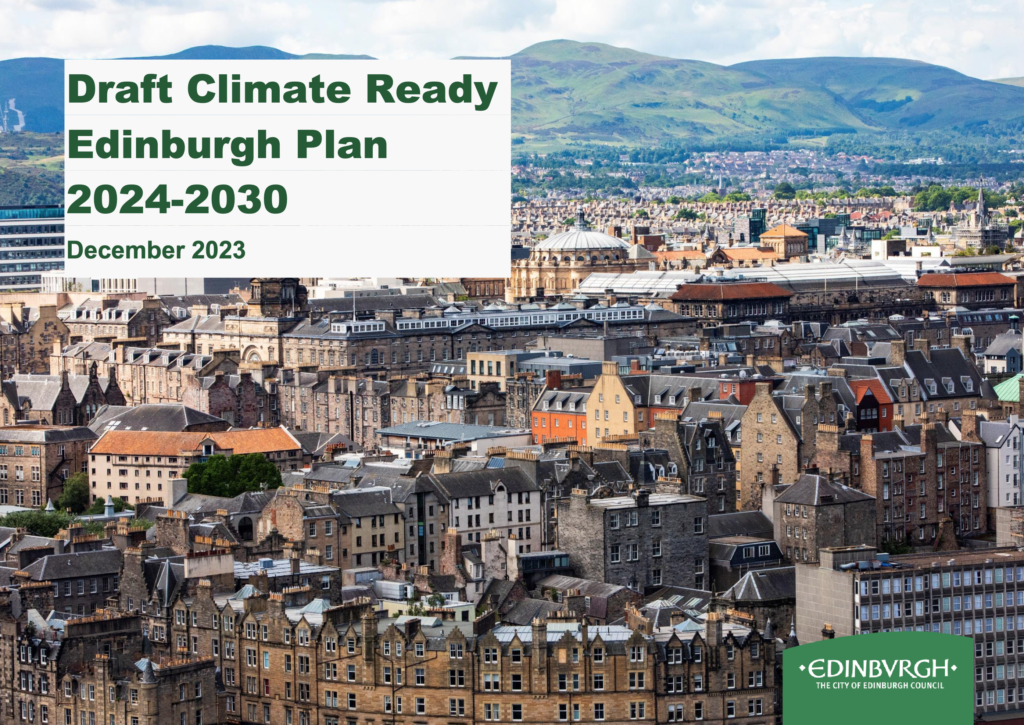On Thursday the 18th of April, Architype’s Edinburgh studio welcomed Fiona MacLeod and Julie Waldron – the City of Edinburgh Council’s Senior Climate Change and Sustainability Officer, and Climate Change Programme Manager – to the Old Assembly Hall for a built environment sector workshop around the developing Climate Ready Edinburgh adaptation plans.
The Edinburgh Adapts partnership is a collaboration between the City of Edinburgh Council, Historic Environment Scotland, Nature Scot, NHS Lothian, Scottish Water, Edinburgh College, Sniffer, Heriot Watt University, Edinburgh Napier University, the University of Edinburgh. SEPA and Edinburgh World Heritage.
The ongoing consultations on the draft plans close on the 6th of May, and you can take part in the consultation here.
Adaptation is a more pressing concern than you may have thought. When we imagine climate actions we can take, we need to expand our focus beyond carbon and look at new ways to proactively design and prepare for what is coming. Even if carbon emissions were to be reduced to zero tomorrow, historical emissions and pollution will cause continual warming and planetary dysregulation far into the future.
As Fiona and Julie explained to workshop participants, climate science is showing that we have collectively and consistently underestimated the speed and the magnitude of climate degradation. This means that the built environment that exists today is not prepared for the climate changed future of tomorrow – so must be adapted, and any buildings to be built, must be designed with adaptability in mind, based on these projections. The recently published 3°C Neighbourhood research co-authored by CIVIC SQUARE and Dark Matter Labs is an example of what this can look like.
Read the Draft Climate Ready Edinburgh Plan here
To put this into a Scottish context: recently published research from the James Hutton Institute determined that Scotland’s rainfall is already at levels of intensity and regularity that prior climate models assumed we would reach around 2050. Meaning, growing numbers of buildings in Scotland are unprepared for the climate of the future. Air pollution, overheating, surface water flooding, coastal erosion, rising sea levels, extreme weather events and heatwaves, drier summers, and rainier winters, are all set to increase in both frequency and intensity, and designing buildings are that are resilient to a changing climate is critical.
It’s important that serious discussions about adaptation – beyond the mitigation of embodied and operational carbon emissions, are taking place as we design. As serious plans about adapting to this new climate reality are co-developed by local authorities it is important that they are supported by hands-on experience from the construction sector and informed by the lived experiences of local community groups.
Advocating for collective and joined up solutions that stack community and environmental benefits, like Blue-Green infrastructure, and encouraging the implementation of KPIs that centre our health, such as the Centric Lab’s Biological Inequities Index, are ways that we can exercise our agency. Another action that we can take is to open our studios and co-host events in partnership with local authorities and organisations – like this one – creating opportunities to share our expertise, and to deepen collaborations, to imagine what local adaptation might look like, and to envision how its realisation might be carried out as part of a Just Transition of society at large.
After an introduction to the Adaptation Partnership and their work illustrating the climate future Edinburgh is expecting, the workshop opened out into a discussion between participants on how their work intersects with the adaptation necessary in the city.
Ewan Griffin, Associate Director at Harley Haddow commented:
“It was a really thought-provoking discussion session and it is good to see the City of Edinburgh Council taking the topic so seriously and looking to put policy in place. The built environment has one of the worst carbon footprints, and although we need to mitigate climate change where we can, it is clear that we are not moving the needle far enough in the right direction. Climate change is coming and we need to be designing the built environment to be ready for the new normal and so talking about adaption and policy around this is key, the sooner the better. The idea of introducing a new designation for a protected ecological zone for blue and green networks was a particularly interesting and encouraging proposal.“


